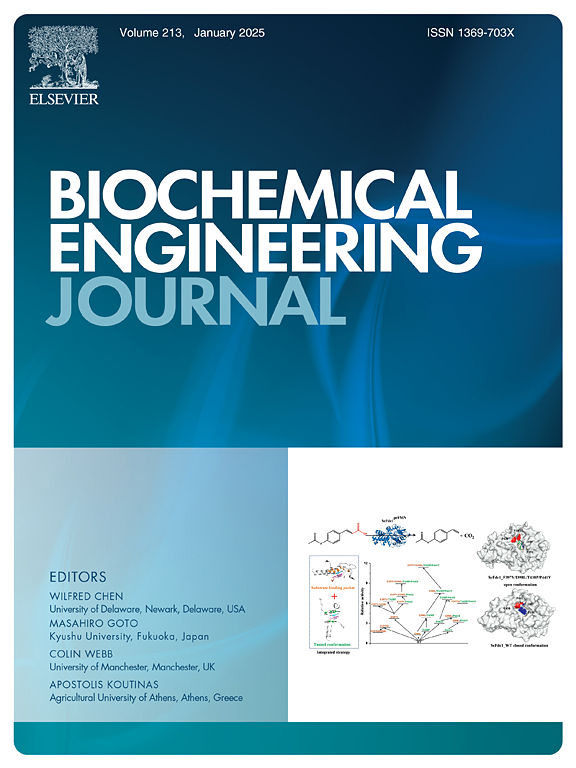无溶剂脂肪酶催化苯连菌素与三乙酰素乙酰化反应的动力学模型
IF 3.7
3区 生物学
Q2 BIOTECHNOLOGY & APPLIED MICROBIOLOGY
引用次数: 0
摘要
酶催化类黄酮和类黄酮苷改性的动力学,特别是连续加成多个官能团的动力学研究很少。目前唯一可用的模型与酶动力学原理不一致。我们建立了一个简单的动力学模型,以脂肪酶在无溶剂体系中催化苯连菌素的乙酰化为例进行了研究。我们的模型假设乙酰化是不可逆的,溶剂/乙酰供体的浓度保持不变,脂肪酶在一级过程中失活。我们通过拟合以三乙酰素为乙酰供体的脂酶催化苯连菌素乙酰化的文献数据来估计模型的参数。我们的模型很好地拟合了在几种初始苯并菌素浓度下获得的苯并菌素、苯并菌素-6′- o -乙酸酯和苯并菌素-3′,6′- o -双乙酸酯的剖面。估计参数为:对苯并菌素的特异性常数为0.380 h−1%(w/v)−1,对第二次乙酰化的选择性为0.362,对苯并菌素-6”- o -乙酸酯的饱和常数为22.3 mmol L−1和76.5 mmol L−1,对苯并菌素-3”,6”- o -二乙酸酯的抑制常数为3.5 mmol L−1,一级变性常数为0.0125 h−1。我们的工作不仅提出了一个模型,很好地描述了苯连菌素的乙酰化,它也证明了一种建模和参数估计的策略,可以应用于其他酶催化的类黄酮和类黄酮苷的修饰。本文章由计算机程序翻译,如有差异,请以英文原文为准。
A kinetic model for the solvent-free lipase-catalyzed acetylation of phlorizin with triacetin
Little attention has been given to the kinetics of enzyme-catalyzed modification of flavonoids and flavonoid glycosides, especially the successive addition of multiple functional groups. The only currently available model is not consistent with the principles of enzyme kinetics. We developed a simple kinetic model, using the lipase-catalyzed acetylation of phlorizin in a solvent-free system as a case study. Our model assumes that the acetylation is irreversible, the concentration of the solvent/acetyl-donor remains constant and the lipase inactivates in a first-order process. We estimated the parameters of the model by fitting it to literature data for the lipase-catalyzed acetylation of phlorizin, with triacetin as the acetyl-donor. Our model fitted well to profiles for phlorizin, phlorizin-6”-O-acetate and phlorizin-3”,6”-O-diacetate obtained at several initial phlorizin concentrations. The estimated parameters were a specificity constant of 0.380 h−1%(w/v)−1 for phlorizin, a selectivity of 0.362 for the second acetylation in relation to the first, saturation constants of 22.3 mmol L−1 for phlorizin and 76.5 mmol L−1 for phlorizin-6”-O-acetate, an inhibition constant for phlorizin-3”,6”-O-diacetate of 3.5 mmol L−1 and a first-order denaturation constant of 0.0125 h−1. Our work not only presents a model that describes well the acetylation of phlorizin, it also demonstrates a strategy for modelling and parameter estimation that can be applied to other enzyme-catalyzed modifications of flavonoids and flavonoid glycosides.
求助全文
通过发布文献求助,成功后即可免费获取论文全文。
去求助
来源期刊

Biochemical Engineering Journal
工程技术-工程:化工
CiteScore
7.10
自引率
5.10%
发文量
380
审稿时长
34 days
期刊介绍:
The Biochemical Engineering Journal aims to promote progress in the crucial chemical engineering aspects of the development of biological processes associated with everything from raw materials preparation to product recovery relevant to industries as diverse as medical/healthcare, industrial biotechnology, and environmental biotechnology.
The Journal welcomes full length original research papers, short communications, and review papers* in the following research fields:
Biocatalysis (enzyme or microbial) and biotransformations, including immobilized biocatalyst preparation and kinetics
Biosensors and Biodevices including biofabrication and novel fuel cell development
Bioseparations including scale-up and protein refolding/renaturation
Environmental Bioengineering including bioconversion, bioremediation, and microbial fuel cells
Bioreactor Systems including characterization, optimization and scale-up
Bioresources and Biorefinery Engineering including biomass conversion, biofuels, bioenergy, and optimization
Industrial Biotechnology including specialty chemicals, platform chemicals and neutraceuticals
Biomaterials and Tissue Engineering including bioartificial organs, cell encapsulation, and controlled release
Cell Culture Engineering (plant, animal or insect cells) including viral vectors, monoclonal antibodies, recombinant proteins, vaccines, and secondary metabolites
Cell Therapies and Stem Cells including pluripotent, mesenchymal and hematopoietic stem cells; immunotherapies; tissue-specific differentiation; and cryopreservation
Metabolic Engineering, Systems and Synthetic Biology including OMICS, bioinformatics, in silico biology, and metabolic flux analysis
Protein Engineering including enzyme engineering and directed evolution.
 求助内容:
求助内容: 应助结果提醒方式:
应助结果提醒方式:


